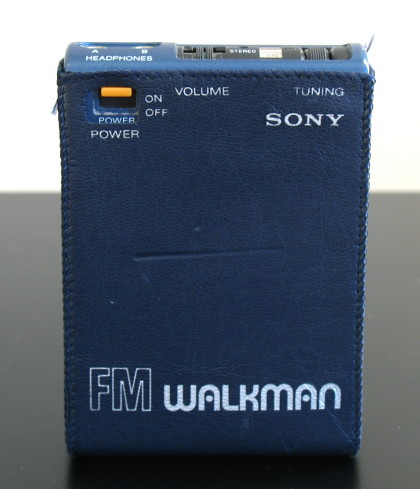
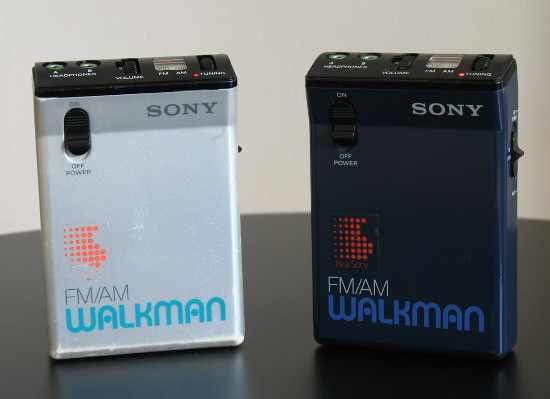
From left to right: Sony SRF-40W FM receiver and two Sony SRF-22W AM/FM receivers.
I originally began posting brief reviews of vintage radios at a blogging site established by the developer of the Opera browser. That site was called, logically enough, MyOpera. A couple of years after I started posting, Opera arbitrarily yanked my account, never giving a reason or even responding to inquiries from me. I was able to recover some material, but there were several posts that were lost. I still had the photos, but the text was gone.
About a decade intervened between those events, and the writing of this article. Since then, new-generation radios using digital signal processing (DSP) chips have become increasingly available, setting a new standard in sensitivity and selectivity, particularly for FM reception. With that perspective in mind, let's turn our attention back to the vintage Walkmans that were originally reviewed in the latter part of the first decade of this century. How much have radios improved in the last ten years or so?
The short answer is: a lot. Even the best of the Sony Walkman radios, the FM-only SRF-40W (pictured at left above, shown in the vinyl cover supplied with the unit) is, in some ways, surpassed by most DSP-based radios, though I have found that it's still pretty good. The AM/FM SRF-22W (pictured in two colors at right above) can't hold a candle to most DSP-based radios when it comes to FM reception, while AM reception is substantially less different than what you'd get with a DSP-based radio.
Because of their AM stereo capabilities, I have written separate articles for two Walkman models: Sony SRF-A1 (1983-85) | Sony SRF-42 (1990s)
The remainder of this article is about FM-only and AM/FM Walkmans. There were many Walkman models, including tape players and recorders that included radios as one of their features. In particular, this article focuses on six models that span the 1980s.
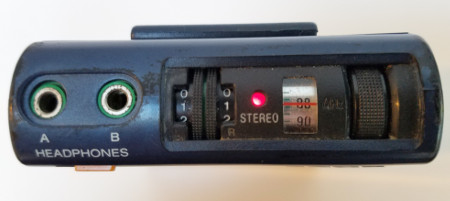
Top of the Sony SRF-40W, showing two headphone outputs, separate left-channel and right-channel volume controls, a stereo indicator LED, and the drum-style tuning dial.
Sony SRF-40W and SRF-30W
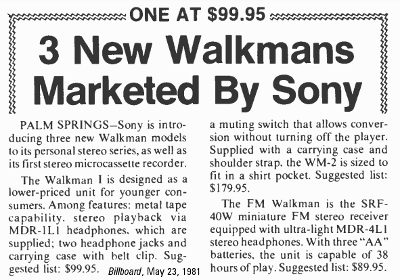
In the year after its wildly successful introduction of the Walkman tape player, Sony introduced the SRF-40W.
As mentioned in my review of the Proton 100, high-fidelity-oriented publications such as Audio or Stereo Review didn't give much coverage to Walkman or similar units. Billboard provided a little more coverage, as shown by the article at right from the May 23, 1981 issue (fair use excerpt, larger version available), announcing the introduction of three new Walkman models. Among them was the SRF-40W, Sony's first radio-only Walkman.
Note the suggested list price of $90. The equivalent cost in 2020 would be more than $240! It's likely that many people who bought this radio paid less than $90, of course.
In my experience, the SRF-40W turned out to be one of the most capable of the Walkman radio models, even considering that it was designed exclusively for FM reception. It wasn't at the level of the Proton 100, but it was still pretty good. Its construction quality was much better than the Proton 100, which is rather fragile. The SRF-40W is sturdy and solid.
Later Walkman FM (and AM/FM) radio models were more cheaply built and usually had fewer features, probably due to marketplace pressures to keep the price of the radios down. In fact, I don't recommend most Sony Walkman FM (or AM/FM) radios, but the SRF-40W is one that I can recommend for listening to all but the weakest stations in a given area.
Unlike most Walkman radio models, the SRF-40W (as well as the SRF-30W) requires 3 AA batteries, rather than one or two. (See the back of the SRF-40W at right.) Most Walkman radio models need 2 AA batteries; a few use either AAA batteries or need just one AA battery.
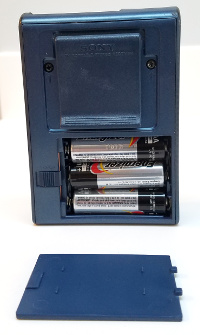
In addition to better FM reception compared to later Walkmans, the SRF-40W featured:
- Two headphone outputs
- Separate left-channel and right-channel volume controls
- A protective cover (as seen in the left photo at the beginning of this article)
The belt clip on the back of the unit was a common feature among Walkmans, though often removable. Not so on the SRF-40W: the clip is an integral part of the unit.
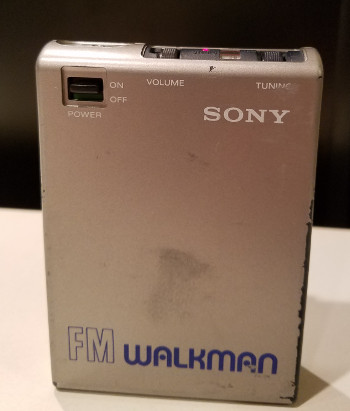
The SRF-30W (left) was a very similar model to the SRF-40W. Both models featured FM reception only, had two headphone outputs, required 3 AA batteries, and had a non-detachable belt clip. In head-to-head comparisons with the SRF-40W, the SRF-30W performs nearly the same as the SRF-40W, though, in some circumstances, it can be slightly less sensitive. I can't discern any difference in audio performance between the models. The only difference appears to be the volume control: the SRF-30W has only a single volume control, rather than the separate left and right-channel controls of the SRF-40W.
After having disassembled an SRF-40W in order to perform a simple alignment adjustment, I would actually cast my vote for the SRF-30W's single volume control. The dual controls on the SRF-40W are held together in the unit's case only by the pressure of surrounding controls, plus a plastic washer that separates the two controls. The stereo LED indicator is also embedded in one of the volume controls! I found that placing those two controls back in the unit properly was immensely difficult to get right. It was also annoying to have to take the entire unit apart to align it, but that tends to be typical of pocket-sized electronics.
I've seen only one color for the case of the SRF-40W: a dark blue. I have the SRF-30W in two colors: a silver case and a red case.
In my experience, the SRF-30W and the SRF-40W are the only worthwhile models for good FM reception. Generally speaking, their performance is the same, though, on occasion, the 40W might get one or two weak stations that the 30W would miss. But this doesn't happen consistently. For all practical purposes, I believe the two models are equally competent performers. The majority of other Walkman FM models that I have used are mediocre or poor performers.
Walkman "vintages" and models
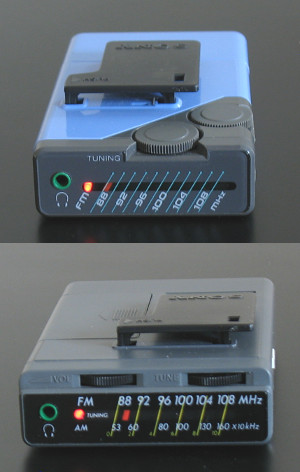
Precise information on the dates that various Walkman units were for sale is surprisingly hard to find. I guess Walkmans were so common in the 1980s that no one gave much thought to documenting these dates for future historians. As indicated by the 1981 Billboard article, the SRF-40W was introduced around the middle of that year. However, I don't know when it was discontinued. I have even less information about the SRF-30W. It could have been available at the same time as the SRF-40W, but at a slightly lower price, reflecting the use of a single volume control rather than two controls. More likely, I believe it was the successor to the SRF-40W, with the single volume control being a way of reducing Sony's costs of making the unit.
For other models, sources vary regarding dates. For the models that I have, these are the best dates I've been able to find:
- Sony SRF-A1 (separate page): 1984 to 1985.
- Sony SRF-42 (separate page): 1994 to 1999.
- Sony SRF-16W (upper right): 1987. The SRF-20W appears similar.
- Sony SRF-19W (lower right): 1985 to 1987.
- Sony SRF-22W (in the right photo at the beginning of this article): 1985. Given the similarity of its profile and size with the SRF-40, I'm questioning this date. I suspect it may have been available before 1985.
- Sony SRF-35W (lower on this page, has three-band graphic equalizer): 1985 to 1987.
Walkman reception performance
In head-to-head comparisons among the various Walkman models, the FM-only versions seem to perform better on FM than those with both AM and FM reception capability. For the AM/FM models, AM performance seems to be very similar, though I noticed an odd drop-off in sensitivity for the SRF-22W above 1260 kHz (where there is a local signal in the San Francisco Bay Area). Only one of my SRF-22W's actually works now (the blue one shown in the right photo at the beginning of this article; the silver one doesn't do anything) so I wasn't able to determine if this was a problem specific to the working unit that I have.
None of these radios has a separate antenna for FM reception. They use the headphone cord as an FM antenna. This can impair the radio's ability to receive signals, and can lead to more variability in reception as well. Still, for these radios, convenience trumps performance.
Even with possibly compromised reception capability, these units have a "local/DX" switch for a reason. Most of them are prone to what's called front-end overload. Without additional circuitry, if there are too many strong signals in an area, the radio will begin generating false signals at other locations on the dial, swamping weaker signals that it otherwise could have received. It appears that most Sony FM circuits were as minimal as possible; thus, most of them have this problem. The "local/DX" switch attempts to compensate for inadequate circuitry. The "local" position reduces the strength of the signal coming in from the antenna. The "DX" position is for use in areas without strong stations and does not reduce the radio's sensitivity.
In the FM world of 2020, with low-power signals from LPFM stations and translators proliferating across the dial, and with few areas without local FM stations, the "local/DX" switch is mostly ineffective. It wasn't all that effective to start with.
The SRF-30W and SRF-40W perform better because those models seem to be less prone to front-end overload compared to later models. Most radios of the 1980s and earlier generations are subject to at least a little overload, so the SRF-30W and 40W still can't pluck out the really weak signals that a modern DSP-based radio is capable of receiving. They also have difficulty with the sidebands generated by HD radio signals, which can swamp weaker signals adjacent to strong stations broadcasting in the HD digital system. But those two models still perform fairly well, and will be able to receive all stations available at a given location, except for those with poor signals. Some stereo signals may be noisier than they would be on a DSP-based radio, but the SRF-30W and 40W can still get them, usually without internally generated interference.
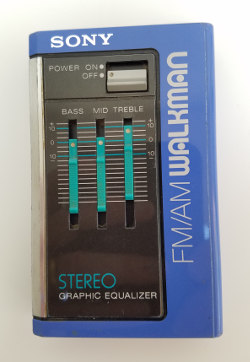
Not so the others. The FM-only SRF-16W and the FM section of the SRF-22W are fair at best. The AM/FM SRF-19W is nearly unusable for the upper half of the FM dial due to overload, even when in "local" mode. The ergonomics on the SRF-19W are also bad. The tuning and volume controls are narrow thumbwheels that are stiff and hard to move with any precision.
The SRF-16W, while seeming to be kind of flimsy, does have smoothly operating controls. The SRF-22W functions in a manner similar to the SRF-40W, including two headphone outputs. The main functional difference is the addition of an AM/FM switch on the right side of the unit. The AM switch also has "local" and "DX" positions, taking the place of the "local" and "distant" switch that the SRF-40W has on its left side.
Despite the interesting addition of a three-band graphic equalizer, making it one of the few Walkman models with something resembling a tone control, the SRF-35W (right) unfortunately performs similarly to the SRF-19W. Like the SRF-19W, the SRF-35W features both AM and FM reception capability. The ergonomics of the SRF-35W are better, with controls working smoothly. But FM performance, in particular, is poor.
Walkman performance comparisons
Station counts aren't always meaningful, because they don't tell you much about the strength of the signals received, but at least they provide some indication of performance. Here's a head-to-head comparison of FM reception performance of Walkmans and modern DSP-based models:
Vintage Walkman models
- SRF-A1: 23 stations (26 in "local" mode!)
- SRF-16W: 26 stations
- SRF-19W: 24 stations
- SRF-22W: 32 stations (25 in "local" mode)
- SRF-40W: 40 stations (one only received in "local" mode; one only received in "distant" mode)
(At the time of this comparison, I had not yet acquired the SRF-30W or the SRF-35W. The SRF-30W generally performs the same as the SRF-40W.)
DSP models
- Degen DE1123: 50 stations
- Tecsun PL-100: 46 stations
- CC Pocket (version 2): 47 stations
- Sangean DT-160: 44 stations (plus one in narrow bandwidth mode)
- Sangean DT-800: 46 stations
Note: The threshold for FM stereo reception seems to be set at a particularly high level for the Sangean units. On the one hand, this means that they won't inflict a noisy stereo signal on you. On the other hand, this means that some stations that might otherwise sound OK in stereo will be received in mono instead. This must be a design decision; how you feel about it will be very much a matter of personal taste.
Conclusion
For their time, the SRF-30W and SRF-40W were good performers and still provide good performance in areas where the FM dial is relatively uncrowded. They even cope well with the very crowded FM dial now present in major cities. But, in some respects, they're now outclassed by the current generation of DSP-based radios, both in performance and in ergonomics. Nonetheless, it's fun to listen to the SRF-40W and the SRF-30W. In my opinion, their audio quality is better than that of DSP-based radios. Even so, the DSP-based products offer many advantages and features that would've been very expensive to implement in the 1980's.Additional pages about Sony Walkman radios
» Sony SRF-40W FM Walkman announced in Billboard, 1981
» Sony SRF-A1 AM stereo/FM stereo Walkman (full review)
» Sony SRF-42 AM stereo/FM stereo Walkman (short review)